JAPAN
Economy

Economy
Cities in JAPAN
| Kyoto | Osaka | Tokyo |
Economy
General
History
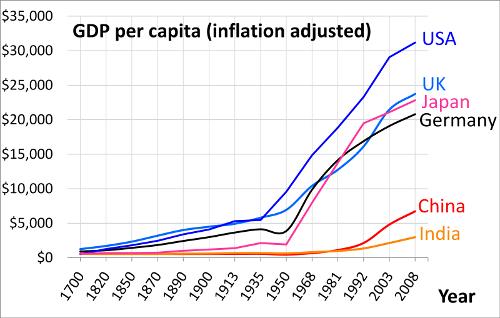 This map shows the changes in per capita GDP of China, Germany, India, Japan, United Kingdom and United States of AmericaPhoto: M Tracy Hunter CC 4.0 International no changes made
This map shows the changes in per capita GDP of China, Germany, India, Japan, United Kingdom and United States of AmericaPhoto: M Tracy Hunter CC 4.0 International no changes made
Since the Second World War, the Japanese economy has grown spectacularly. The raw materials industry developed until about 1953, followed by the consumer goods industry until about 1965. After 1965, the manufacturing industry experienced unprecedented growth in world history.
The basis for this growth was laid by the Americans, who took a number of measures to help Japan on its way again shortly after the Second World War. The Americans themselves also had an interest in an economically strong Japan, fearing that communism would take hold of Japan.
For example, agriculture was reformed, a lot of technology was imported, trade unions were founded and the education level of the employees was brought to a very high level. The close cooperation between government and business, long working hours, import restrictions and low interest rates also resulted in growth in many industrial areas. In the period from 1965 to 1990, the gross national product grew spectacularly at an average of 4.7% per year, the highest percentage in the world. Until the end of the 1980s Japan also showed a very positive trade balance, with much more exports than imports. This gigantic export income made Japan a lender. The United States in particular is becoming increasingly dependent on these credits and there is a growing trade deficit against Japan.
The United States considered this an unacceptable and dangerous situation and after a meeting of the richest states in the world, the G7, it was decided to devalue the dollar and appreciate the yen. In 1985 the dollar costs 240 yen, in 1987 this has already decreased to 120 yen. For example, American exports should pick up again and those of Japan should be slowed down. However, the yen became more and more expensive, so that prices continue to rise and the trade deficit in the United States has barely decreased. Financial surpluses are piling up in Japan and stock market prices (Nikkei index) are rising spectacularly, from 15,000 in 1985 to nearly 40,000 at the end of 1989. Japanese speculators began to deposit their money in US Treasury bills, making Japan the main lender of the US debt. The Japanese multinationals invested all over the world and established industries in East Asia to export from there their products that had become too expensive in Japan itself due to the rise of the yen. As a result, the East Asian countries experienced unprecedented strong economic progress.
Meanwhile, the contradictions between Japan and the United States are growing, and since 1989 the period of unbridled economic growth has come to an abrupt end. The ties between the Japanese banks and the Japanese industry became somewhat looser and the large companies increasingly finance their investments with the large profits. In order to boost the assets of the companies even more, investments were also made in the property sector, which is largely dominated by the Japanese, causing the prices of the land to skyrocket.
In 1989, the stock market started to decline alarmingly fast, falling to 14,000 points in 1992, one third of two years earlier. Bankruptcies succeed one another in rapid succession, particularly at banks that had lent money to questionable companies. For example, the twelfth bank in Japan, the Hokkaido Bank, had to close its doors and Yamaichi Securities, one of the four major stock exchange companies, went bankrupt. As a result of these developments, many layoffs were made, many speculators went bankrupt and private consumption and investment declined: in short, the economy stagnated and production grew less quickly than the other industrial countries.
To prevent the total collapse, the Japanese government is pumping billions into the Japanese economy. In March 1998, for example, a plan was launched to boost consumption again, costing more than nine billion euros. At that time, however, Japan's debts were as large as its gross domestic product.
Situation of the Japanese economy in the 21st century
Economic growth has been modest since 2000. As of 2008, Japan has been in recession three times. The 2011 Tsunami also caused the economy to contract. There is a heated debate in Japan about whether or not to close nuclear power plants after the Fukushima disaster. In 2017, Japan is the fourth largest economy in the world after the United States, China and India. The greatest challenge is curbing the national debt. Some figures on the state of the economy in 2017:
Economic growth is 1.7%. Its GDP per capita is $ 42,900. Unemployment is 2.9%. The national debt is 237% of the Gross National Product. Inflation is 0.5%.
Agriculture, livestock, fishing and forestry
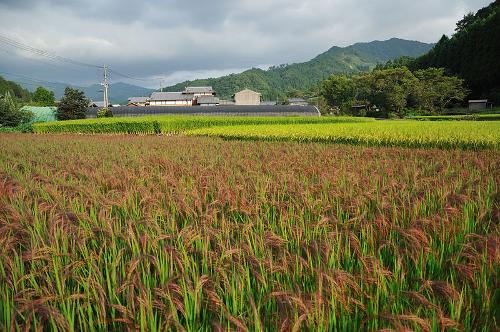 Rice fields JapanPhoto: Gtknj CC 2.0 Generic no changes made
Rice fields JapanPhoto: Gtknj CC 2.0 Generic no changes made
The importance of these primary sectors declined sharply after the Second World War and has fluctuated around 1-1.5% of GDP for a number of years. (1.1% in 2017) Only 3% of the labor force (2017) is employed in these sectors and that number is steadily decreasing. As a result, the self-sufficiency rate in Japan is only 40%, making Japan one of the lowest of the industrialized countries.
Mountainous Japan has little agricultural land available (11% of the area). The main crop is rice, the traditional folk food, for which 50% of the agricultural area is used and is the only agricultural product in which the country can amply provide itself. One-third of the remaining 50% of agricultural land is used as pasture and two-thirds are grown fruit and vegetables such as potatoes, sugar beets, citrus fruits and sugar cane.
Grain and other agricultural raw materials are mainly imported; only 7% is grown in Japan itself, except for silk, flax and to a lesser extent tobacco. The size of the Japanese agricultural companies is very small: an average of approximately 1.2 ha.
Despite a lack of good grazing land and the small farm size, milk is the most important agricultural product today.
Livestock farming, on the other hand, is shrinking, especially pig farming. The number of cattle and dairy farms is also falling slightly. Most of the meat is currently being imported, especially from Australia and the United States.
Japan is one of the most important fishing countries in the world with an annual catch of approximately 6-7 million tons. Before 1940, the catch amounted to between half and two thirds of the total world catch. However, its size has been declining since 1990 as a result of international conflicts over fishing rights and pollution of Japanese coastal waters. The sector has approximately 280,000 professional fishermen, three quarters of whom work for small-scale companies. In addition to fishing, the large companies are mainly engaged in trade, transport and fish processing.
In addition to fish for human consumption, the sea also supplies industrial raw materials, such as seaweed. The inedible fish is processed into fish meal. Japan has a monopoly position in pearl fishing; 95% of the catch is exported. The fishing industry is the basis for an extensive industry and export of canned food. Fish consumption is among the highest in the world: 45% of the animal protein consumption in Japan consists of fish. Despite an international ban on whaling since 1986, Japan simply continues its activities in this field under the guise of scientific research.
The forests cover 67% of the total area, of which approximately 41% by means of planting. However, a lot of wood has to be imported because Japan only provides 20% of the domestic demand. Japan's high demand for tropical hardwood is disastrous for the rainforest. Several countries in Southeast Asia and the United States are the main suppliers.
Energy supply and mining
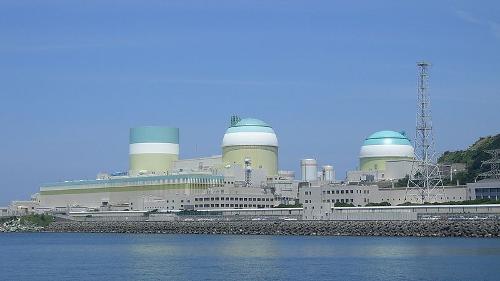 Ikata Nuclear Power Plant, JapanPhoto: Unknown CC 2.5 Generic no changes made
Ikata Nuclear Power Plant, JapanPhoto: Unknown CC 2.5 Generic no changes made
For its energy sources, Japan is dependent on imports for about 82% due to a lack of its own sources. 50-55% of the energy requirement is covered by the import of petroleum from the Middle East and Southeast Asia. Since the two oil crises in the seventies of the 20th century, Japan has been trying to reduce dependence on foreign countries and the possibilities for using alternative energy sources are being studied, in particular solar energy, geothermal power, gasification, coal liquefaction and nuclear power.
The importance of nuclear energy is growing rapidly. After the United States, Japan spends the most money on developing nuclear energy. There is currently a heated discussion about nuclear energy after the Fukushima disaster.
Japan is one of the largest consumers of minerals in the world because it has no natural resources of its own. Japan therefore has to import most of its need for minerals. Japan only has sufficient quantities of limestone for the cement industry, silver, sulfur and pyrite for the production of sulfuric acids. The share of mining in GDP is only a quarter of a percent. Japan is the world's largest importer of coal.
Industry and construction sector
 Toyota JapanPhoto: Turbo-myu-z CC 4.0 International no changes made
Toyota JapanPhoto: Turbo-myu-z CC 4.0 International no changes made
After the Second World War, Japan initially conquered a place on the world market in the field of shipbuilding and the synthetic fiber industry. Subsequently, light industry also conquered a prominent place on the world market. The production grew spectacularly as a result of, among other things, the good cooperation between the government and the private sector, the strong industrial organization and the application of modern technologies. There are a number of methods in the acquisition of technology in Japan: the sectors that are mainly based on foreign technologies such as petrochemicals, synthetic fibers and electronics; the sectors that were already present in Japan before the Second World War and in which much Japanese know-how was invested, but which were reinforced with foreign know-how in the 1950s and 1960s, such as shipbuilding, steel and automotive industry and the manufacture of optical instruments; and the sectors in which foreign know-how has found its own Japanese application, such as in the electronics and computer industry and in systems technology.
Japan is the most productive country in the world after the United States. Within the Japanese economy, industry contributed around 30% to GDP in 2017. This share is also gradually decreasing. The industry, including the major automotive industry, employs 26% of the workforce (2017). Other important industries are machinery, iron and steel, chemical and textile industries.
The second oil crisis in 1979 saw a shift from heavy industry to technologically advanced industry. Since the mid-1980s, many companies have moved their production abroad. This mainly concerns manufacturers of cars and electronics, products often intended for those markets. In the 1990s, industrial production fell significantly as a result of the great economic crisis. One of the major problems in the industry is overcapacity, which leaves companies with large stocks.
The construction industry is important to Japan both politically and economically. However, this sector has also been hit hard. Due to the decline in the value of real estate and the trend to continue production abroad, resulting in fewer factories being built. Many construction companies can barely keep their heads above water.
Trade and the Internet
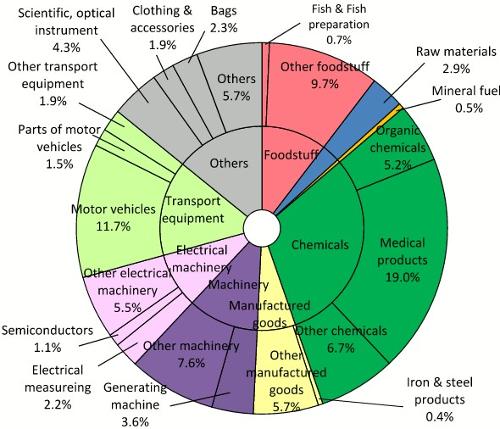 Import Japan from the EUPhoto: Trade Statistic of Japan, Ministry of Finance, 2017 CC 4.0 no changes made
Import Japan from the EUPhoto: Trade Statistic of Japan, Ministry of Finance, 2017 CC 4.0 no changes made
Large trade surpluses characterize Japan's foreign trade. The United States and the European Union are strongly urging for improved market access for their products and services. In recent years, the Japanese government has therefore begun to deregulate the market and make it more accessible to foreign competition. The trade surplus has been declining in recent years.
The main trading partner for Japan is China. In 2017, 19% of exports went to China, while China supplied 24.5% of imports. After China, the United States is Japan's second largest trading partner. Other important importers are South Korea, Hong Kong, the Middle East and Taiwan. Australia, Taiwan and South Korea are the main exporters.
Japan is the leader in the e-business market in Asia. The number of internet users is enormous.
Traffic
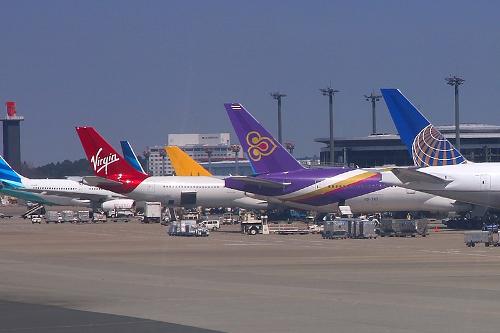
Nariya airport TokyoPhoto: Marek Slusarczyk CC 3.0 Unported no changes made
Sea transport has always been very important because of Japan's location and its dependence on imports of most natural resources.
The main ports are Yokohama, Nagoya, Kobe, Osaka, Moji and the coal ports of Otaru and Muroran. Competition with other ports in the region is fierce and Japan is in danger of losing the competitive battle. Larger ports are those of Hong Kong, Singapore and Kaoshiung in Taiwan.
The Japanese National Railways were reorganized in 1987 into seven private companies: the Japanese Railways (JR) Group consisting of six passenger transport companies and a freight transport company. Japan has a number of super-fast passenger trains. The Tokaido Express covers the Tokyo-Osaka (515 km) route in just over three hours. The Sanyo Express takes less than seven hours to cover the Osaka-Hakata distance (1070 km).
The Seikan Tunnel (the longest in the world at nearly 54 km) has connected the main islands of Honshu and Hokkaido since 1988 and is part of the Tokyo-Sapporo railway link.
In 2013, the road network comprised approximately 1,500 million km, of which 75,000 km are national roads (of which almost 90% are paved). Car ownership in Japan is high, in 2013 95% of the population owned a car. More than 90% of freight transport was by road in 2013.
International airlines are Japan Airlines (JAL), All Nippon Airways (ANA) and Japan Air Systems (JAS). The main airports are Tokyo (Narita), Osaka and Nagoya, and the new Kansai International International Airport in Osaka Bay, the world's first offshore airport. Japan also has a large number of regional airports for domestic flights.
Air transport for the transportation of goods is not very popular. For years, only 1-2% of freight has been transported by air.
Sources
Japan
Lonely Planet
Japan
Reader's Digest
Kamachi, N. / Culture and customs of Japan
Greenwood Press
Scott, D. / Japan
Van Reemst
Shelley, R. / Japan
Times Books
Somerwil, J. / Japan
Gottmer/Becht
Stefoff, R. / Japan
Chelsea House Publishers
CIA - World Factbook
BBC - Country Profiles
Copyright: Team The World of Info